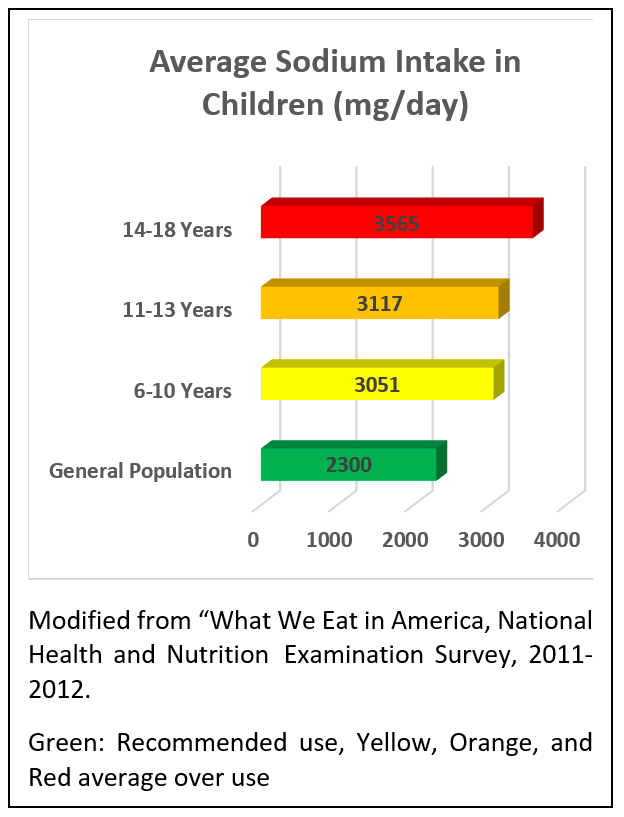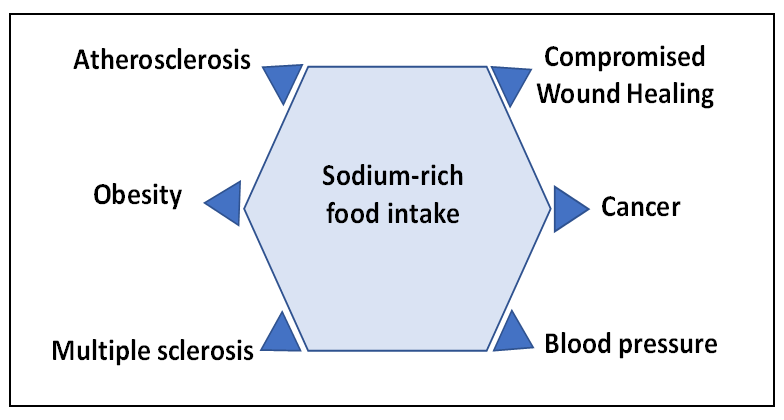Say “Na” to High Sodium Intake in Young World
Healthful Vitality | 09/27/2019 | By Dr. B. R. Achyut, PhD | Say “Na” to High Sodium Intake in Young World

The use of packaged food has increased in the American diet over the past 50 years. Typically, all packaged foods are processed in terms of pasteurization, canning, cooking, milling, dehydration, and freezing. Thus, processed food is significantly different from its original raw form. Processed foods are the major source of added sugar, high fat, and sodium salt (sodium chloride or NaCl). Sodium plays an important role in maintaining osmotic pressure by holding water in or out food content. Also, sodium acts as a preservative (sodium benzoate) and as a flavor enhancer in all processed foods. 70% of sodium comes from packaged and restaurant foods that the American population is eating. The consumption of sodium-rich and less healthy processed food starts from a very young age. Children ages 6-18 years of age receive dietary sodium from breakfast (14%), lunch (31%), dinner (39%), and snack time (16%).

Say “Na” to High Sodium Intake in Young World
Sodium intake in children:
According to the survey done in the year 2012, children ranging from age 6-18 years old are ingesting an increased dose of sodium (3,051-3,565 mg/day). The recommended dose for sodium is much lower (2,300 mg/day) as part of a regular healthy diet for the general American population. According to the CDC report, 9 out of 10 US children consume more than the recommended amount of sodium and 1 out of 9 is at risk of high blood pressure. Similarly, the American Heart Association reported that children (ages 2-19 years) eat about double the recommended amount of sodium every day (>3,100 mg) compared to what is recommended. In the same age range, older children consume more calories and thus, more sodium. Interestingly, 12-19-year-old boys consume the most sodium (4,220 mg/day) compared to girls (2,950 mg/day).
Food category sources of sodium:
According to 2015-2020 USDA guidelines for Americans, the sodium sources are diverse in U.S. population ages 2 years and older.
- Mixed dishes: Pizza (6%), Burgers and sandwiches (21%), meat, poultry, and seafood dishes (6%), rice, pasta, and grain dishes (7%), and soups (4%).
- Protein foods (14%)
- Grains (11%)
- Vegetables (11%)
- Snacks and sweets (8%)
- Dairy (5%)
- Condiments, gravies, spreads, and salad dressings (5%)
- Beverages (not milk and 100% juice) (3%)
Role of sodium and mechanisms of action on health outcomes:
Normally, sodium is considered a crucial electrolyte for nerve and muscle function. Sodium is critical in balancing water inside as well as outside of cells in organs.

Experimental and epidemiological studies clearly suggest that overconsumption of sodium is associated with critical health issues. Increasing concentrations of sodium induce a proinflammatory program and suppress the anti-inflammatory program of the immune system in the body.
Studies indicated that proinflammatory cytokines such as tumor necrosis factor-alpha (TNF-α), interferon-gamma (IFN-γ), interleukin 1-beta (IL1-β), and IL-17 are critical in promoting chronic diseases involving cancer, obesity, hypertension, systemic lupus erythematosus (SLE), transplantation rejection (graft-versus-host disease), atherosclerosis, multiple sclerosis (MS), allergic diseases, and compromised wound healing process. Moreover, the persistent use of a high dose of sodium from the early age of life causes an inflammatory environment in the body that may result in serious health issues later due to altered immune responses. It is recommended that lowering sodium intake in children can help in controlling health issues in present and later life.
Sodium and behavioral problems in children
Food preservatives have a strong link with behavioral changes in children. The most common preservatives/flavor enhancers, such as sodium benzoate and monosodium glutamate, that are used in packaged/processed foods and fruit juices may cause mood disturbance, hyperactivity, headache, and anxiety behaviors. Also, the cooperative effect of other preservatives (sugars, nitrites, and nitrates) with sodium compounds may further enhance behavioral issues in children. Indeed, several factors, including behavioral problems influence for to say “Na” to high sodium intake in young world.
Possible solutions and recommendations to teachers and school system
When it comes to serving nutritious food to children in schools, the whole nation has largely failed. Schools are relying on packaged foods that are high in preservative including sodium compounds. According to the Federal School Lunch Program started in 2010, new guidelines were made to lessen the amount of sodium in the school cafeteria. The recommended sodium amount was 1230-1420 mg/day (lunch) and 540-640 mg/day (breakfast) in the school cafeteria. These regulations have curbed the problem to some extent, but the routine use of preserved, processed, and packaged food may still cause health issues.
Children need food and health education at the school level. Teachers should play a critical role in advocating this issue to the school administration at the state and national level. Schools need a defined healthy lifestyle curriculum like other subjects. This will help children to identify food labels and low sodium processed foods. One of the permanent solutions could be cooking fresh food with a low amount of sodium in every school kitchen, like other institutions. Most importantly, we as a community need a strong movement and government support to fix this problem at the school level right now.
Possible solutions and recommendations to parents
Nowadays, children are smart and independent from a very young age. When it comes to food, one of the major problems with children is eating healthy food. Most healthy foods are neglected by children partly due to their friends’ eating behaviors. Children follow what their friends take from the school cafeteria. That is why children need parental support for complex issues such as health. It is the primary responsibility of parents to look after the eating habits of children. There are several ways of controlling sodium overuse. Mostly, parents have no time to cook and they rely on packaged foods, which is considered processed and high levels of sodium.
However, cooking fresh food with lower sodium, at least twice a week, could solve the problem at a certain level. Freezing freshly cooked food for the whole week may also limit the problem, which is better than eating processed food for the week. Alternatively, parents could identify foods in grocery stores with low to moderate ranges of sodium. Monitoring sodium intake routinely is possible through a diet chart and weekly calendar. Moreover, parental education is very important when it comes to raising a child with a proper diet plan and providing breakfast, lunch, dinner, and snacks during the day.
Related Article: Boosting Body’s Immunity to Curb Cancer Incidence
References:
- Sodium and Children: CDC report
- Sodium and Kids: American Heart Association
- 2015-2020 Dietary Guidelines for Americans
- WHO Guidelines: Sodium intake for adults and children
- Role of salt for immune cell function and disease: https://onlinelibrary.wiley.com/doi/full/10.1111/imm.12915
- 5 Foods That Negatively Affect Your Child’s Mood
- Hyper Kids? Cut Out Preservatives
- School Lunch Debate: What’s at Stake?
Author:

Dr. B.R. Achyut is a Biologist, Educator, Innovator, Scientific Writer, and Aspiring Entrepreneur in the field of Cancer. He is working as an Associate Scientist at Winship Cancer Institute of Emory University. He has earned a Ph.D. in Cancer Inflammation and Genetics from India at Sanjay Gandhi Postgraduate Institute of Medical Sciences, Lucknow. In the year 2009, he came to the National Cancer Institute at National Institutes of Health, Bethesda for Postdoctoral Fellowship. Later, he moved to Henry Ford Health System, Detroit (2013) and Augusta University, Augusta (2014).
He significantly contributed to the tumor microenvironment area of cancer focusing on Upper GI, breast, and glioblastoma preclinical models. His seminal research work is published in several international cancer and therapy journals. He is recognized as a “Top 10 in 10” list of “Young Professional to Watch 2017” by Augusta Magazine and Augusta Chamber of Commerce. Later, Georgia Trend Magazine in 2017 recognized him as a “40 under 40” in the state of Georgia. He is a big fan of Cricket game. In the past, he established “Augusta Cricket League” and recently, “Suwanee Avengers” Cricket team in Georgia.
